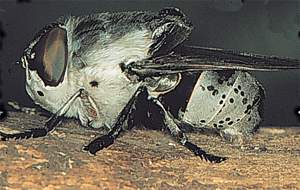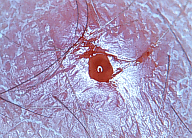Bot Flies, aka Torsalo or Dermatobia hominis Bot flies (Order Diptera, Family Cuterebridae) are large, stout bodied, hairy flies that resemble bumblebees. The botfly egg is deposited by a mosquito or sometimes by another insect. The larva grows in the host's body until it is fairly large. The botfly larva can easily be killed by taking away its air supply -- by putting vaseline or similar on the skin where the lump is, but then you still have to extract the larva. Adult botflies have nonfunctional mouthparts and do not feed. Larvae of this species parasitize wild and domestic rabbits. Females deposit their eggs in or near the entrance of their host's burrow. Bot fly larvae penetrate their host through the skin or natural body openings after hatching. The larvae form a tumor (called a warble) in the subdermal zones of their host and remain at this location until larval development is complete. Larval development varies among species, ranging from 20 to 60 days. Before pupating, the larvae leave the host's skin and drop to the soil. Bot flies (Order Diptera, Family Cuterebridae) are large, stout bodied, hairy flies that resemble bumblebees. The botfly egg is deposited by a mosquito or sometimes by another insect. The larva grows in the host's body until it is fairly large. The botfly larva can easily be killed by taking away its air supply -- by putting vaseline or similar on the skin where the lump is, but then you still have to extract the larva. Adult botflies have nonfunctional mouthparts and do not feed. Larvae of this species parasitize wild and domestic rabbits. Females deposit their eggs in or near the entrance of their host's burrow. Bot fly larvae penetrate their host through the skin or natural body openings after hatching. The larvae form a tumor (called a warble) in the subdermal zones of their host and remain at this location until larval development is complete. Larval development varies among species, ranging from 20 to 60 days. Before pupating, the larvae leave the host's skin and drop to the soil.Generally, the host is not severely damaged by this parasite. The majority of the injury occurs when the larvae exit the host through the warble. Parasitism by the botfly does not affect the edibility of the rabbit (assuming you eat rabbit), generally the area adjacent to the warble is trimmed away, and the rest of the rabbit is suitable to eat. Is there such a thing as a human bot fly? Yes, we're sorry to say there is. Called the torsalo,Dermatobia hominis, occurs in Mexico and Central America. Fortunately, getting one is an extremely unlikely occurrence for the average visitor.
One of the really cool things about this insect is that it lays its eggs on a mosquito and the eggs hatch when the mosquito feeds on a host. Do humans get warbles? Yes, (are you disgusted yet)?
While the maggot feeds on its host (you) it has to have a hole in the skin so it can continue to breath. It takes about 6 weeks to complete development on its host. There are stories of entomologists rearing torsalos on themselves in order to get a good specimen of an adult (which are rarely captured), but we regard this as taking your profession a little too far. Read more at http://ambergriscaye.com/pages/town/botfly.html |
Bot Flies, aka Torsalo or Dermatobia hominis
Search
Total Pageviews
Popular Posts
-
Use forceps to remove bot fly larvae from under the skin. Bot fly myiasis is a condition that is guaranteed to literally and figuratively m...
-
Bot Flies, aka Torsalo or Dermatobia hominis Bot flies (Order Diptera, Family Cuterebridae) are large, stout bodied, hairy flies that res...
-
How to Remove a Bot Fly From Under the Skin Bot flies lay their eggs on mosquitoes. If a mosquitoe bites you, the eggs can hatch under...
-
Bot Flies , or Oestridae, are small hairy flies that are often mistaken for bees. They become issues when your horse becomes a host for the...


0 Comments Received
Leave A Reply